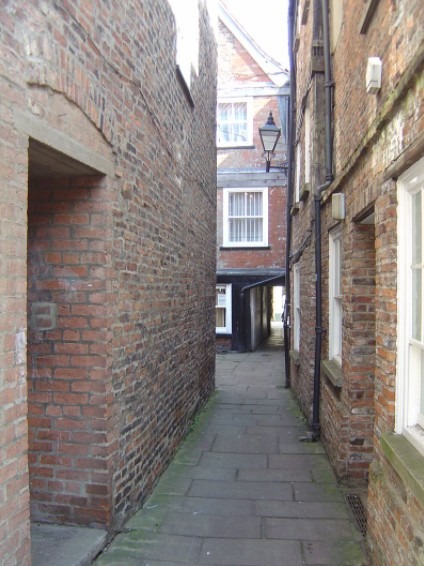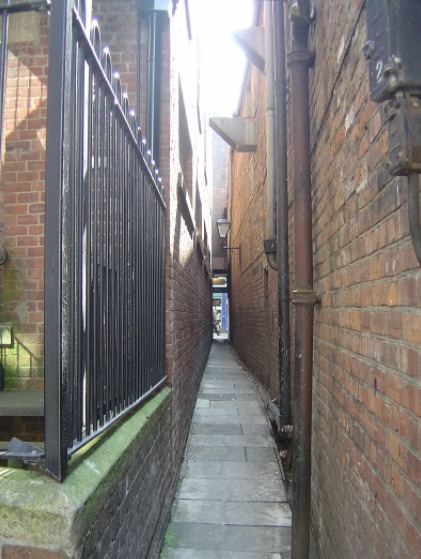The word “Snickelways” first appeared in the book of author Mark W. Jones in 1983 entitled A Walk Around the Snickel ways of York. Jones coined the term, and was a portmanteau of the word snicket, meaning a passageway between walls or fences, ginnel, a narrow passage between or through buildings, and alleyway, a narrow street or lane. Despite being a neologism, the word quickly became part of the local vocabulary and has even been used in official council documents, such as when giving notice of temporary footpath closures.
Initially, snickelway refers to any small and narrow streets and footpaths in the city of York, England. You can typically see these in-between buildings, not wide enough for any vehicle to pass down, but merely function as public rights. According to Jones, “A Snickelway is a narrow place to walk along, leading from somewhere to somewhere else, usually in a town or city, especially in the city of York.”
The city of York is home to these types of passage and paths, mostly medieval, though there are some modern paths. Mostly, they have names like any other city street, but often have fascinating or peculiar names such as Mad Alice Lane, Finkle Street (formerly Mucky Peg Lane), Nether Hornpot Lane, Lady Peckett’s Yard, and Whip-ma-Whop-ma gate. Each has its own historical narrative
Let’s have a journey through these snickelways and have a glimpse of their past how they got their names.
Petergate, part of the Minster Quarter, stands on the Roman Via Principalis, the first-century main east-west route through the Roman fortress. The street is no named due to its proximity to York Minster, dedicated to St Peter.
In the medieval, gates refer to the walled city of York or streets that lead to openings in the city walls, while the entrances through the walls are called bars.
About mid-way up the street, on the left side, there is a round sign announces The Hole-in-the-Wall Pub. It is likely to reference the Bootham Bar, once known as ‘The Board Inn,’ and is believed to be haunted by the mysterious footsteps. A dark secret was revealed after an excavation of the Board Inn carried out in 1816. It was found out that the hole led into a dungeon where chains and manacles hung. Also found was a bricked-up tunnel.
Besides it, just before the Hole-in-the-wall entrance, there is the Little Peculiar Lane, one of the oldest passageways in York and opens onto a snickelway known as Precentors Court, a stunning view of York Minster.
One of the main entrances through York’s historic city walls, in common with Bootham Bar and Micklegate Bar, was used to display the traitors’ heads, Thomas Mowbray, Earl of Norfolk, and Earl Marshal. They led a failed rebellion against Henry IV in 1405.
Stretching at about 220 feet long, leading off Stonegate, the Coffee Yard is the longest snickelway. It contained Barley Hall, a reconstructed medieval townhouse, which was originally built in about 1360 by the monks of Nostell Priory, a monastery near Wakefield.
One of the narrowest and darkest York’s snickelways is the Pope’s Head Alley, measuring only 80cm wide. In ‘Eboracum,’ Francis Drake mentioned that it is the favored haunt of many of the ghost walks in the city.
Tucked in between shops in the busy shopping district of Goodram Gate is the Bedern Passage that leads to another of York’s hidden medieval treasures. Between a Mind charity shop and Caesar’s Italian Restaurant at 29 Goodram Gate, this opening bears a resemblance to a delivery entrance for the modern commercial city center, yet it’s not.
The ginnel, Bedern Passage, is a path beside the ancient remains of Bedern Chapel. The chapel and the nearby hall are remnants of the College of the Vicars Choral of the Minster, which was consecrated in 1349. Referred to as the “common hall”, Bedern Hall is just nearby. Initially, it functioned as a refectory or dining hall for the choral. Today, it can be rented to cater occasions like weddings, private parties and meetings. On the summers, it hosts teas that are open to the public.
Journeying and exploring York via its historical passages, ginnels, and snickelways, is a unique way of traveling back and experiencing the past in the midst of a bustling, modern city.

